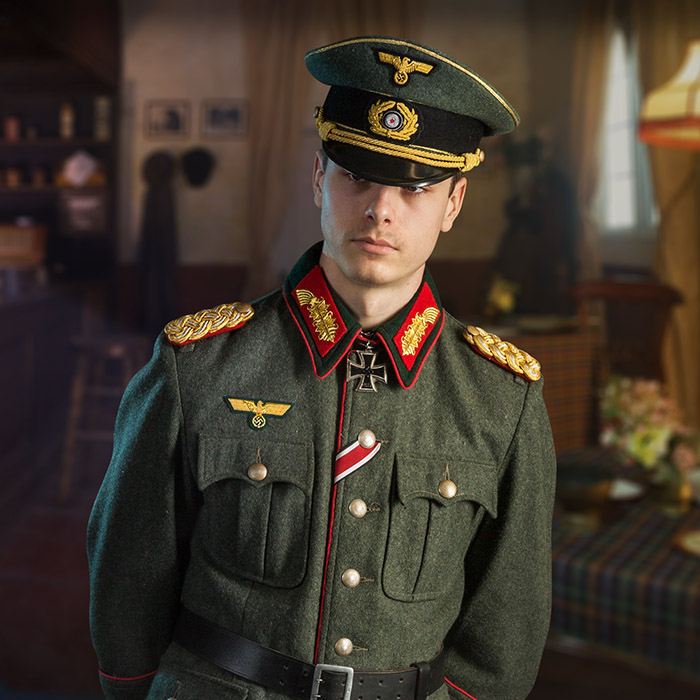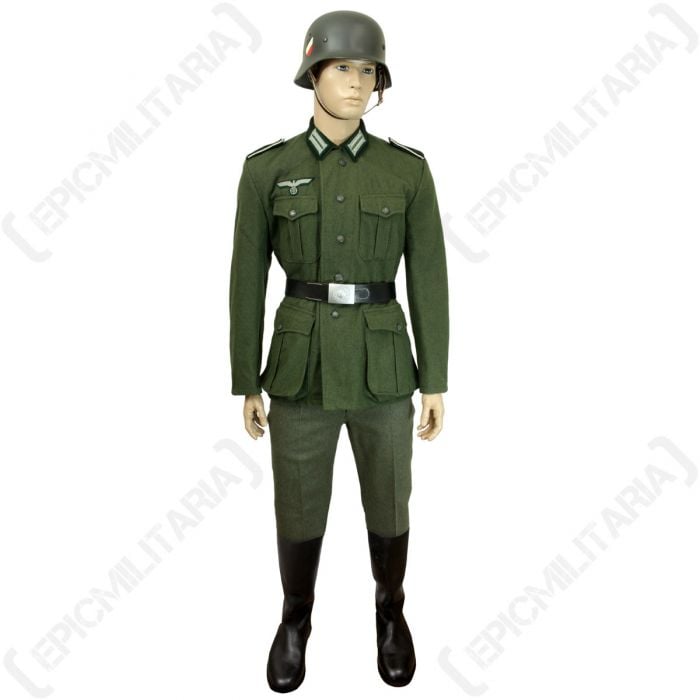
Army Uniform Modern German Army Uniform
Uniforms on the Eastern Front References and literature In the German army there were two kinds of uniform: standard uniforms, which were issued by the Wehrmacht, or from the wearer personally at their own or state-cost tailor-made uniforms.

World War Two Army Uniform Daily Sex Book
The German Army, or Heer, had strict guidelines for its uniforms. Soldiers were expected to wear the standard field uniform, known as the Feldgrau, which consisted of a gray-green tunic and trousers. Officers and non-commissioned officers had additional distinctions, such as piping, braid, and shoulder boards, indicating their rank and branch of service.

German soldiers offered free travel in uniform to 'boost army visibility'
2. Service Uniform. a. GENERAL. Whereas many armies have both dress and service uniforms, in the German Army the service coat (Waffenrock) and trousers serve as the basis for the following varieties of dress: (1) Gesellschaftanzug.This is the dress uniform, which in turn is divided into grossen (ceremonial) and kleine (ordinary) Gesellschaftanzug.

german army soldier in ww2 uniform at glen miller festival Stock Photo
The army's service uniform consists of a light gray, single-breasted coat and darker gray trousers, worn with a light blue or white shirt, black tie, and black shoes. The peaked, visored cap has been replaced by the beret as the most common form of headgear. Dress uniforms featuring dinner jackets or double-breasted coats are worn by officers.

Pin on 軍服
In this section you will find our range of WW2 German Uniforms as worn in the Third Reich by the different services of the German Armed Forces in WW2, the Oberkommando des Heeres (German army), Oberkommando der Marine (Germany Navy) and the Oberkommando der Luftwaffe (German Air Force).

Pin on Mitsto
The uniforms of the Germany Army in World War One from 1914 to 1918. Uniforms of the infantry 1914/15 and 1916-18, mountain troops and Jaegers, Bavarian soldiers, Landsturm and cavalry, the general staff.. German uniforms World War One > The 'All Highest' cabinet order of 21 September 1915 introduced a completely new field uniform consisting.

GDMajor Wwii uniforms, German uniforms, Military uniform
Wehrmacht uniforms and insignia.jpg 1,500 × 1,117; 928 KB. WW2 German Army Uniforms Rank insignia National emblems Headgear Field Afrika Korps Collar pathces Shoulder-straps Newsmap Vol 1 No 43 2-15-1943 US Government National Archives NARA Unrestricted Public domain 26-nm-1-43 002 cropped.jpg 14,066 × 10,525; 21.74 MB.
German army uniforms and insignia. UNT Digital Library
Fastening Accessories (1) Field Jackets (1) Field Shirts (4) First-Aid & Hygiene (2) Flags, Badges & Insignia (3) Fleeces & Jerseys (2) Gloves (1) Goggles (2) Great Coats (1) Harnesses (2) Helmets (2) Hiking Packs (2) Holsters (1) Jacket Liner (1) Kit Bags (2) Laptop Bags (1) Leather Jackets (1) Load Accessories (1) Load Belts (1)

WW1 Imperial German Infantry Soldier Photograph. in Photos
This is the largest page and describes the evolution of the Preußen (Prussian) Waffenrock (uniform) from introduction in 1842 to the introduction of the Feldgrau (field grey) uniforms in 1907/10. The Waffenrock was worn by the majority of German foot units and some cavalry units.

Imperial German Soldier WW1 M15 uniform + Stahlhelm Minecraft Skin
As standard, Army personnel wear a beret, a flat, brimless cap made of felt, velvet or lined silk whose colour indicates which branch they are in. Air Force personnel usually wear a blue side cap - as opposed to the berets worn by the Guard Battalion, for example - with their basic service dress, while Navy personnel generally wear a cap with th.

WW1 Imperial German Soldier uniform 1916 with webbing
The development of the German uniform from then until now is best understood if we consider six distinct eras: Prussian Army (1701-1871) Imperial German Army (1871-1918) Reichswehr (1919-1935) Wehrmacht (1935-1945) Nationale Volksarmee (East Germany, 1949-1990) Bundeswehr (West and unified Germany, 1955-present) Prussian Army (1701-1871)

WW1 Imperial German Officer Pattern 08 uniform WW1 German Army uniforms
The uniforms and insignia of the Schutzstaffel (SS) served to distinguish its Nazi paramilitary ranks between 1925 and 1945 from the ranks of the Wehrmacht (the German armed forces from 1935), the German state, and the Nazi Party . Uniform design and function 2nd pattern SS Totenkopf, 1934-45

Pin en WWII INFANTRY
Uniforms of the Heer as the ground forces of the Wehrmacht were distinguished from other branches by two devices: the army form of the Wehrmachtsadler or Hoheitszeichen (national emblem) worn above the right breast pocket, and - with certain exceptions - collar tabs bearing a pair of Litzen ( Doppellitze "double braid"), a device inherited from.

Military uniform German soldiers flecktarn 03 by MazUsKarL
German military uniforms are known for their attention to detail and functionality. These uniforms incorporate several key features that contribute to their distinctiveness and suitability for various military operations. Camouflage Patterns: German military uniforms often feature camouflage patterns designed to blend in with different terrains.

WW2 German Enlisted Man Uniform Epic Militaria
R Reichsheer belt buckles (22 F) S Stahlhelm M16 (1 C, 154 F) Stahlhelm M17 (2 F) Stahlhelm M18 (3 C, 40 F) Stahlhelm M18 Fernsprecher und Kavalleriehelm (16 F) U Uniformen der alten Armee (Waldorf-Astoria, 1932) (34 F) Media in category "Uniforms of the German imperial army of World War I"

Германско маскировъчно облекло German Soldiers Ww2, German Army
Pages in category "German military uniforms" The following 24 pages are in this category, out of 24 total. This list may not reflect recent changes. B. Tropentarn; C. Corps colours (NPA) Corps colours (Waffen-SS) Corps colours of the German Army (1935-1945)